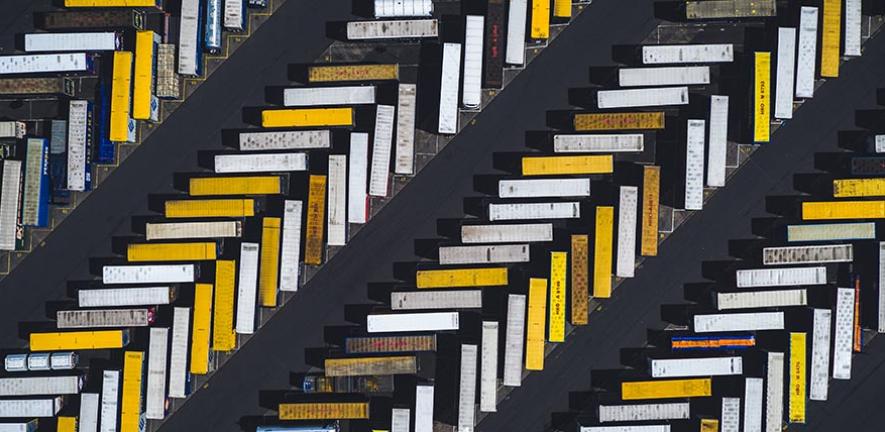
The COVID-19 pandemic highlighted the interconnected nature of global supply chains, and showed how a disruption in one part of the world can have global effects. In 2021, supply disruptions were cost the global economy an estimated $1.9 trillion.
The COVID-19 pandemic highlighted the interconnected nature of global supply chains, and showed how a disruption in one part of the world can have global effects. In 2021, supply disruptions were cost the global economy an estimated $1.9 trillion.
Understanding supply chain interdependencies between companies, sectors, and countries is vital for many challenges
Alexandra Brintrup
An international team of researchers, including from the University of Cambridge, are calling on government agencies and national banks to support an effort to map the billions of connections in the global supply network which, among other impacts, could reduce tax evasion by as much as €130 billion (about £113 billion) annually in the European Union.
The researchers say that understanding supply networks could also improve supply security, promote objective monitoring of the green transition, and strengthen human rights compliance. Writing in the journal Science, they emphasise that international alliances, backed by government organisations and the research community, are needed for such an understanding.
Even though most companies know their immediate trading partners, they depend on countless other relationships up and down the supply chain. A shortage anywhere in the supply network may affect suppliers, suppliers of suppliers, and so on, as well as customers and their customers’ customers.
“Supply disruptions caused an estimated loss of 2% of global GDP in 2021 – approximately $1.9 trillion (£1.6 trillion) – and significantly contributed to the current high inflation,” said lead author Anton Pichler from the Complexity Science Hub (CSH) in Vienna. “For a long time, it was unthinkable to analyse the global economy at the company level, let alone its complex network of supply interconnections. That is changing now.”
“Understanding supply chain interdependencies between companies, sectors, and countries is vital for many challenges, from identifying how disruptions may emerge and cascade across economies, through to monitoring carbon emissions and ensuring ethical and sustainable practice,” said co-author Professor Alexandra Brintrup from Cambridge’s Institute for Manufacturing.
For almost a century, only aggregated data – such as the average values of entire sectors – could be analysed. Predicting how individual company failures would affect the system was simply not possible. What happens to the economy when a specific company stops its production? What if an earthquake paralyses an entire region?
“Now, a combination of new micro-datasets, methods based in machine learning, and multiple government initiatives are creating the ability to map entire economies, which can give us the tools to answer some fundamental questions with real and timely impact,” said Brintrup.
Although the volume of data is vast – there are approximately 300 million companies worldwide, each with an average of 40 domestic suppliers, resulting in up to 13 billion supply connections – researchers can map the connections between individual companies.
Currently, value-added tax (VAT) data is the most promising option for reconstructing reliable large-scale supply networks. Countries including Spain, Hungary and Belgium use a standardised VAT collection that practically records all domestic business-to-business (b2b) transactions. With these, it’s possible to map the entire national trade of a country.
In most countries like Germany, Austria, or France, where VAT is not collected for individual b2b transactions but only accumulated over a specific period, such mapping is not possible.
“The standardised b2b collection could reduce administrative overheads for companies and would contribute substantially to tax compliance,” said co-author Christian Diem, also from CSH. Estimates suggest that VAT-related fraudulent activities in the European Union (EU) amount to €130 billion annually.
Beyond tax evasion, other global challenges also depend on the detailed knowledge of supply networks. “For individual companies, it’s nearly impossible to ensure that all trading partners, their suppliers, and their suppliers’ suppliers operate in an environmentally friendly way and in compliance with human rights,” said Pichler. “If this were centrally documented in a gigantic network, it could be more easily ensured.”
The next step is to link trade data from different countries. Currently, the EU records trade in goods between its member states at the company level. If it also included services and linked them with VAT data, this could lead to a comprehensive cross-border company-level network. According to the authors, this would represent almost 20% of the global GDP.
The European Commission laid the legal foundation by proposing ‘VAT in the Digital Age.’ “Unfortunately, this is far from being realised,” said co-author Stefan Thurner, of the Complexity Science Hub. “So far, we do not have a single situation where the supply chain networks of any two countries have been joined and merged. This would be an essential next step.”
To create a truly international picture of supply interconnections, hundreds of datasets must be joined, analytical tools developed, and an institutional framework must be created, together with secure infrastructure for storing and processing enormous amounts of sensitive data.
“To advance this endeavour, a strong international alliance of various interest groups is required, including national governments, statistical offices, international organisations, central banks, the private sector, and academia,” said Thurner. The first collaboration in science, involving authors in macroeconomics, supply chain research, and statistics, now aims to establish a foundation. The researchers hope to inspire others to join their efforts.
The researchers hosted representatives of European ministries, national banks, statistical offices, and researchers at a workshop in Vienna on 5–6 June 2023.
Reference:
Anton Pichler et al. ‘Building an alliance to map global supply networks.’ Science (2023). DOI: 10.1126/science.adi7521
Adapted from a CSH press release.

The text in this work is licensed under a Creative Commons Attribution-NonCommercial-ShareAlike 4.0 International License. Images, including our videos, are Copyright ©University of Cambridge and licensors/contributors as identified. All rights reserved. We make our image and video content available in a number of ways – as here, on our main website under its Terms and conditions, and on a range of channels including social media that permit your use and sharing of our content under their respective Terms.




